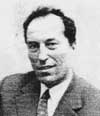
Raimond Castaing (CNRS gold medallist in 1975), inventor of the electron microprobe utilising X-ray secondary emission from a PhD subject given by André Guinier, and his followers, have developed new methods for quantitative chemical analysis at smaller and smaller scales, from micro- to nano- and now at the individual atom scale. Among these methods, it is worth noting the use of ion secondary emission with the development of the first analyser, which served as the prototype to all a family of instruments built since 1969 under CAMECA patent.
These ion analysers (so-called “of Slodzian”) are largely used in metallurgy, material sciences, geo- and cosmo-chemistry, biology, medicine, and recently, a new generation of scanning ion microscopes (nano-SIMS) has appeared. To be mentioned in the 60’s, too, is the introduction of the energy filter (the so-called “Castaing-Henry filter”) in the columns of transmission electron microscopes, which opened the way to energy filtering of images and to spatially resolved energy loss spectroscopy. New generations of these instruments now equip the totality of microscopes arriving on the market. In the laboratory, they played a key role in visualising, analysing, and studying defects, aggregates, nanotubes and other objects nowadays at the heart of nanosciences. Through its many theoretical and experimental studies on aggregates in the 60’s and 70’s, the laboratory strongly contributed to initiate this field of research.
